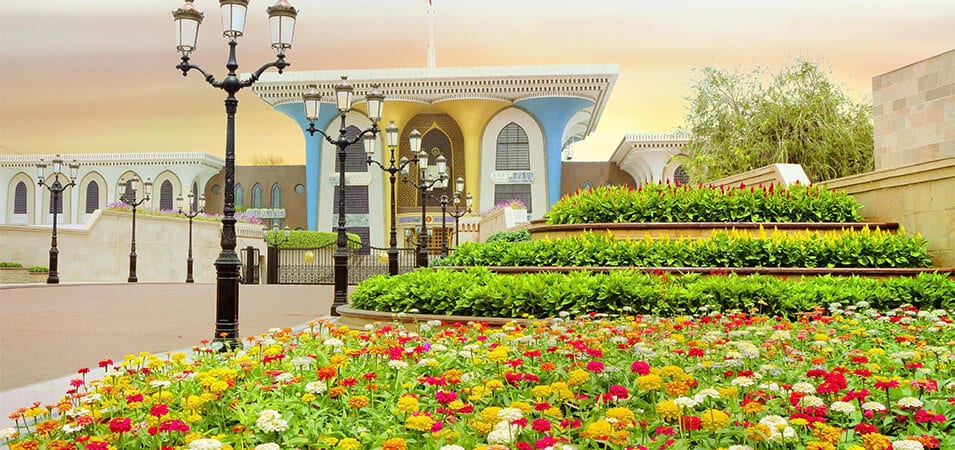Al Alam Palace, located in the heart of Muscat, the capital city of the Sultanate of Oman, stands as a beautiful testament to the nation’s rich heritage and royal legacy. This magnificent palace, also known as the “Flag Palace,” serves as the ceremonial residence of His Majesty Sultan Qaboos bin Said Al Said and offers a glimpse into the grandeur and elegance of Omani architecture. In this article, we will explore the fascinating history, architectural splendor, and cultural significance of Al Alam Palace.
Al Alam Palace has a storied history that dates back to the early 1970s when His Majesty Sultan Qaboos bin Said Al Said ascended to the throne. The palace’s construction was completed in 1972, and it has since become an iconic landmark of Oman, symbolizing the nation’s modern renaissance under Sultan Qaboos’ visionary leadership.
Don’t Miss checking out our Oman Tour Packages.
Architectural Marvel: A Fusion of Traditional and Contemporary Design

Al Alam Palace showcases a remarkable blend of traditional Islamic and contemporary architectural styles. The three main gates of the palace are adorned with intricate gold and blue mosaic patterns, reflecting Omani craftsmanship and attention to detail. The exterior features stunning arches and columns, while the vibrant colors of the palace’s facade pay homage to Oman’s rich cultural heritage.
The Majestic Facade: A Delight for the Senses
The magnificent facade of Al Alam Palace welcomes visitors as they approach. The bright colors, predominantly blue and gold, create a visually captivating experience. The fluttering flags surrounding the palace add a touch of grandeur and national pride.
Lavish Interiors: An Opulent Display of Omani Craftsmanship
The interiors of Al Alam Palace are equally breathtaking. Intricate hand-carved wooden doors adorned with traditional Omani motifs lead to opulent reception halls and lavishly decorated rooms. The palace’s design showcases Omani craftsmanship, with ornate chandeliers, hand-woven carpets, and intricately painted ceilings contributing to its regal ambiance.
The Palace Grounds: An Oasis of Tranquility
Nestled between the Al Jalali and Al Mirani forts, Al Alam Palace is surrounded by beautifully manicured gardens and fountains. The serene ambiance of the palace grounds offers visitors a peaceful retreat amidst the bustling city. Lush greenery, vibrant flowers, and strategically placed seating areas are ideal for leisurely walks and quiet contemplation.
Cultural Significance: Hosting State Events and Welcoming Dignitaries
Al Alam Palace plays a vital role in Oman’s diplomatic affairs. It serves as a venue for hosting state banquets, official ceremonies, and receptions for visiting dignitaries. The palace’s strategic location near the harbor enables it to warmly welcome foreign heads of state and reinforce Oman’s reputation as a nation of cultural significance.
Al Alam Palace in the Modern Era
Al Alam Palace has witnessed various historical events and significant moments in Oman’s contemporary history in recent years. It serves as a symbolic backdrop for royal addresses and official announcements, reflecting the continuity of Oman’s monarchy and its commitment to progress, stability, and peace.
Preserving Heritage: Al Alam Palace as a National Symbol
Al Alam Palace represents Oman’s rich cultural heritage and reminds the nation of its commitment to preserving its traditions. The palace is a national symbol of unity, pride, and resilience, fostering a sense of belonging among Omanis and capturing the essence of the country’s past, present, and future.
Tourism and Visitor Experience
Recognizing its cultural and historical significance, Al Alam Palace welcomes tourists and visitors who are eager to explore Oman’s architectural marvels. Guided tours provide an opportunity to appreciate the palace’s grandeur, learn about Omani traditions, and gain insight into the nation’s royal legacy.

Frequently Asked Questions
Can visitors enter Al Alam Palace?
No, the palace is not open for public entry, but guided tours are available to admire its exterior and learn about its history.
How can I book a guided tour of Al Alam Palace?
Guided tours can be booked through authorized tourism operators in Muscat or the official Oman Tourism website.
Is photography allowed at Al Alam Palace?
Photography is permitted outside the palace, capturing its magnificent facade and surrounding gardens.
Are there any restrictions on the dress code while visiting Al Alam Palace?
Visitors are advised to dress modestly and respectfully while visiting any cultural or religious sites in Oman.
What is the best time to visit Al Alam Palace?
The cooler months from October to April offer pleasant weather for exploring Muscat and its attractions, including Al Alam Palace.
Conclusion
Al Alam Palace is a proud testament to Oman’s cultural heritage, blending traditional aesthetics with modern elegance. From its majestic facade to its opulent interiors, the palace mesmerizes visitors with its architectural splendor. As a symbol of Oman’s royal legacy, Al Alam Palace reflects its commitment to preserving its heritage while embracing progress and sustainability. A visit to this magnificent palace offers a glimpse into Oman’s rich history and the enduring legacy of its monarchy.
Don’t Miss checking out our Related Article :
